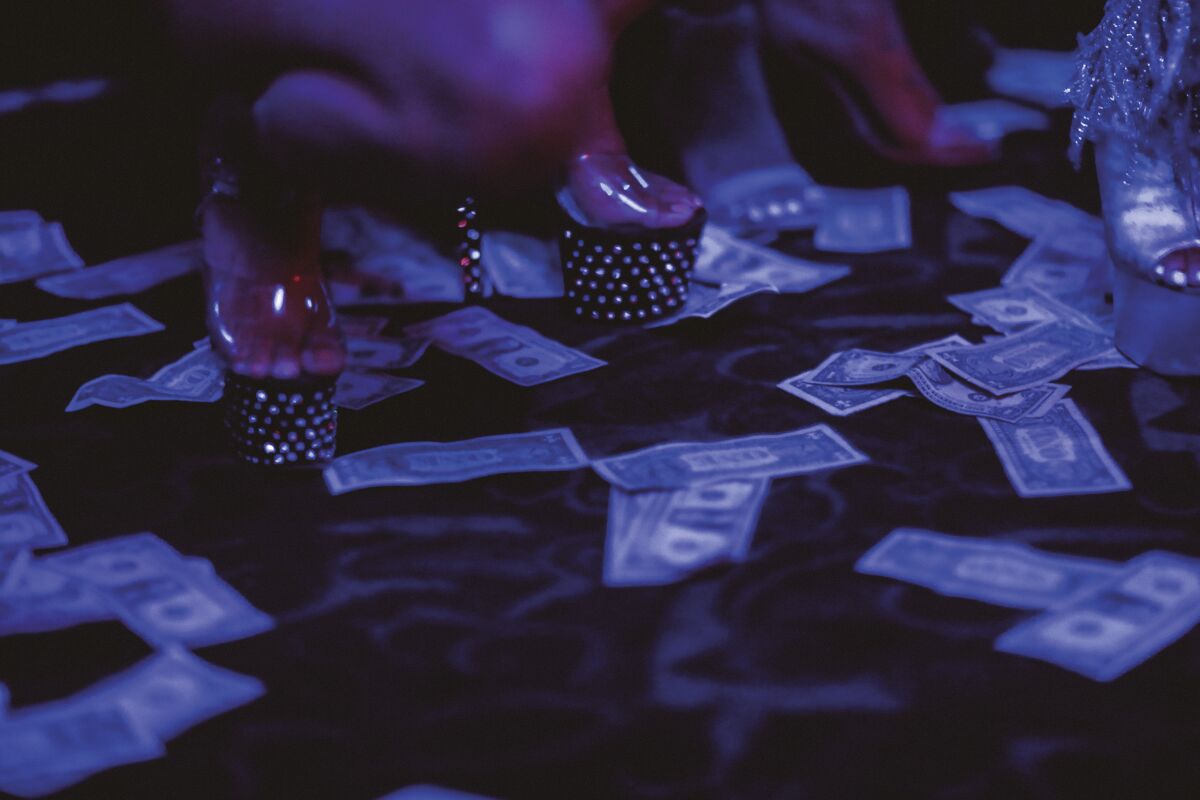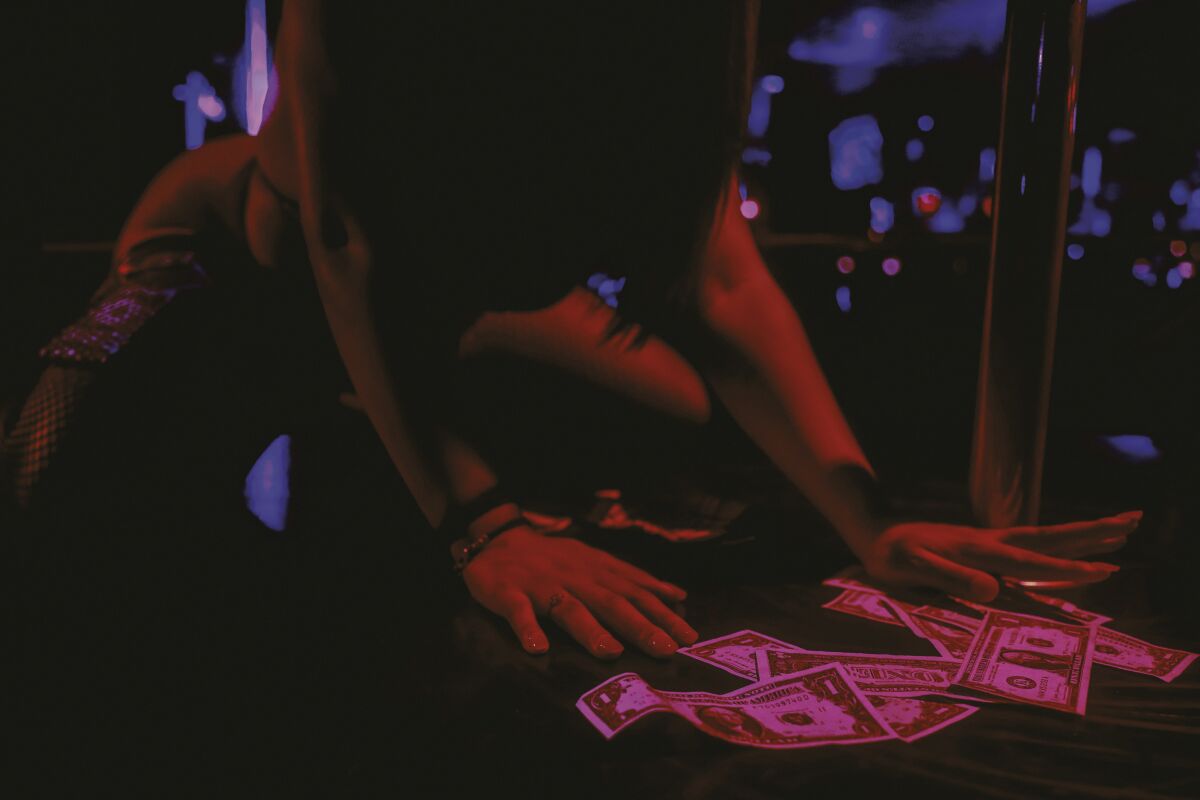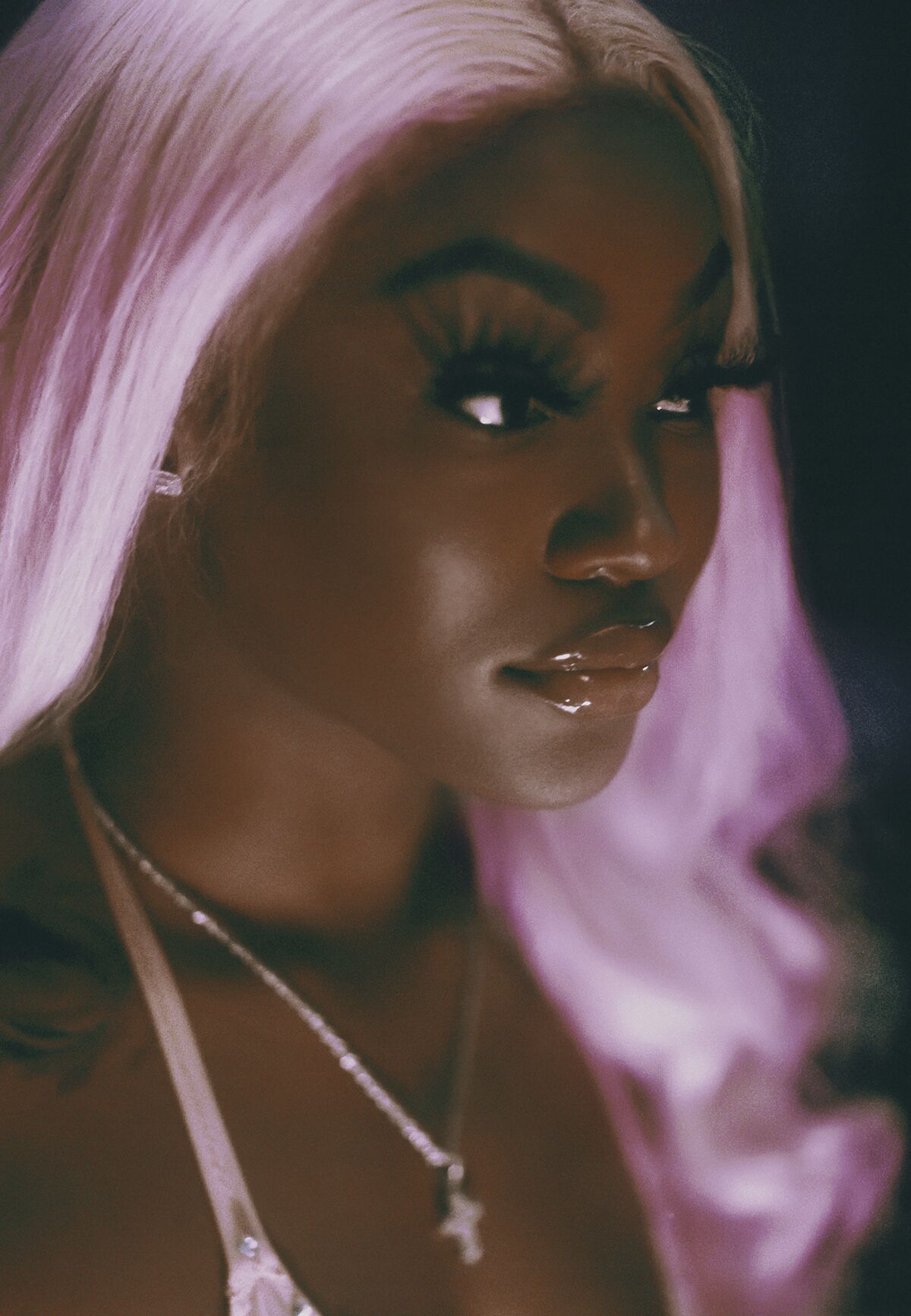Two strip-club art photographers compare notes on race, region and what makes a good shot
On the Shelf
‘ONYX’
By Adrienne Raquel
Damiani: 144 pages, $55
If you buy books linked on our site, The Times may earn a commission from Bookshop.org, whose fees support independent bookstores.
When photographer and creative director Adrienne Raquel set out to document strippers, the Houston native set her lens on the city’s famed Club Onyx.
The intention of photographing the upscale Black club (shot to look “like a 1990s Hype Williams video”) was to “grant the chance for these performers to be as elevated as the culture they influence.”
The photos were shown in Raquel’s first solo exhibition, at New York’s Fotografiska in 2021, and have now been compiled into the book “ONYX,” published by Damiani.
“ONYX” joins a tradition of photo books that includes Susan Meiselas’ “Carnival Strippers” (1976), Bronwen Parker-Rhodes and Emily Dinsdale’s “Wanting You to Want Me” (2022) and Elizabeth Waterman’s “Moneygame: Where Women Rule the Stage” (2021), all of which provide a respectful, female perspective on a $7.6-billion industry that is often stigmatized and marginalized.
“What separates the dancers in a strip club from other performance artists?” asks Nandi Howard in the book’s foreword. “… The performers on these stages continue to serve as a blueprint for popular culture and artists across a multitude of industries, while their art form is largely disregarded.”
On the occasion of “ONYX’s” publication, Raquel sat down with Waterman, whose “Moneygame” was shot at dozens of clubs across Los Angeles and three other cities, for a conversation, edited below for length and clarity, on how strip clubs vary across the country and how the dancers feel about their cultural influence.

“Where Dreams Lie” from Adrienne Raquel’s “Onyx.”
(Adrienne Raquel)
Waterman: The first thing I noticed when I was looking at your work is the aesthetic: beautiful, glossy, magazine editorial [style]. One thing that I’m going to take a note from is you got in close. What did you like about coming in tight like that?
Raquel: Prior to 2016 I would take still-lifes and architectural and scenic photos, all of which — you focus in on the details. I just recently shifted my focus toward photographing people,. Traditionally when we think of strip clubs, it’s not a quiet place, it’s lively. You’ve got the music booming, the bass going, money flying, the girls, alcohol, hookah smoke. So with these images, you can really focus on the woman, which was the goal for this.
Waterman: I loved it because it wasn’t sexualized, and you and I had that in common. We’re looking at these women with different eyes than a man, but these are sensual moments because they’re so close.
I’ve had mixed reactions from dancers about their likeness being borrowed in popular culture. Some of them say, “It’s great that strippers are glorified in the media in shows like ‘P-Valley’ and with Cardi B and FKA twigs and all these people who are doing pole dancing. But we’re still looked down upon when we’re the generators of this image.” Did you get any feedback from the dancers about what that’s like for them?
Raquel: The dancers were more than happy to be part of the project. No one objected. Films like “Hustlers” and hip-hop artists like Cardi B and City Girls depict sex work and stripping in such a glamorous light. Whereas when you actually go inside these clubs, you see that it’s not easy. I made it very clear — when I was getting consent — how they would be shown. Most of the girls that I approached were like, “Hell yeah, let’s do it.”
In the South, strippers are celebrated in many ways. I don’t know how many friends of friends I have who are strippers. And I think that it doesn’t hold the same negative regard that it does in other places.

“Blue Bills” from Adrienne Raquel’s “Onyx.”
(Adrienne Raquel)
Waterman: The South was the one place I really didn’t go and hearing you talk about it makes me really want to. I definitely felt the urban clubs I went to in other cities had more of a celebratory vibe. They were the most fun. I’m thinking specifically of G5ive in Miami, Crazy Girls in Los Angeles, they were so much fun. And the women were these celebrated performers, they were superstars.
Raquel: Absolutely. Within the South, specifically Miami, Atlanta, Houston, even Dallas, some of the girls that work in these clubs, they’re like celebrities.
Waterman: There were girls at G5ive in Miami that had a million followers on Instagram.
Raquel: Houston is known for its music culture, food and the club scene. And being in the club is not just for men. When I got the inspiration to go to Onyx, I went with my mom and my aunt. People go there for birthday parties, baby showers, bachelorette parties.
Waterman: I feel about 98% of the feedback I got from sex workers about the book was positive. And then I got maybe a couple of people that said, ‘You shouldn’t be making money off of the book.’ I feel like strippers and sex workers are so sensitive to people getting one over on them, because they’ve been gotten over on a lot. Did you ever come across that sensitivity?
Raquel: No, I did not. I was very forthcoming with the women I photographed for this project. I was very genuine in my approach, we had this sort of unspoken bond. The book is an extension of an exhibition at Fotografiska where on the opening night, the girls flew to New York. I paid for their hotels. I wanted them to be there personally.
I received a lot of messages from people who took their families, like: “Thank you so much for doing this, my grandmother saw this and she is usually against everything but she thought it was beautiful.” Ultimately that was the goal, to shift people’s perceptions of what exotic dancers and the women that work in these spaces represent.

“Cash is King” from Adrienne Raquel’s “Onyx.”
(Adrienne Raquel)
Waterman: My favorite pictures in the book were the portraits in the locker rooms. Was there anything about those moments that was distinct?
Raquel: So the entire series is broken down into three categories: the up-close, detailed, stylized [shots of] what the women were wearing; these portraits that are more in the beauty realm of things; and then these locker room shots, which … are probably some of the most intimate. I photographed almost 50 to 60 girls. I had thousands of images. I basically selected photos of the women that I bonded with the most.
Waterman: I got the best images from the dancers where I invested the most time in them and we had moments that were really just the two of us. The locker room was my favorite place. Did you encounter any backlash from the patrons of the club?
Raquel: I didn’t really encounter any backlash from any men and I purposely shot this series with no men included. I just wanted to empower and focus on the women. I feel like the entire nature of the series would have been completely changed if I had included the men. But what I also found surprising about the club is that there were so many women there who were either showing love to their homegirls or throwing money because they have it and they just wanted to give it to another woman.
Waterman: What year was that shot in again?
Raquel: I shot that during the pandemic.
Waterman: It’s really an homage to how fabulous Black clubs are. I have noticed, maybe since Black Lives Matter, some of the whiter clubs have more Black dancers, thicker women now. I was at Sapphire Vegas recently. Usually it’s pretty white. I feel like the Black women at Sapphire used to be white-ified. But do you see ways in which Black clubs are influencing culture at large?
Raquel: I think that’s dependent on the city, but Black culture, Black people, Black women in general, influence the world. I mean, if you think about the amount of women who have been getting their butts done or their lips done — that’s derived from Black women. That comes from Black beauty. Girls who are getting their nails done, they’re getting [intricate] designs, that’s Black [culture and aesthetics].
Waterman: I don’t think that credit is very often given.
Raquel: It’s not. And I think when it comes down to beauty, personality, style, attitude, the way we move, the way we talk … most women have a certain je ne sais quoi about them but … I’ve been to strip clubs in L.A., I’ve been to strip clubs in New York. I’ve been to the ones in the South. And when it comes to sex and sexuality, Black women are still very much desired.

“ViXxen,” from Adrienne Raquel’s photobook “Onyx.”
(Adrienne Raquel)
Waterman: Some of the first clubs I went to were in the Bronx. It was my first real experience with a Black club and they were my favorites. I suppose it was because the women were really welcoming and I loved the fashion. Oh my God, some of the nails I saw in Miami, like $200 manicures, gems up the wazoo, probably 4 inches long. They were so unabashedly sexual.
Raquel: It’s such a multilayered space. I would love to go to Atlanta and Magic City. The only reason I didn’t is because Houston is home and I felt like I need to put on for my city.
Waterman: Where do you see the future of strippers going? Because I think quarantine really propelled them into being autonomous and self-generative. A lot are transitioning to OnlyFans, cam work, becoming more responsible for their own income. You see strippers unionizing in Los Angeles.
Raquel: Houston, unlike most parts of the country during the pandemic, was like, “What pandemic?” Houston was open. Outside the club I did notice a lot of the girls were turning to internet resources. I definitely see sex work going beyond clubs.
I think stripping in America is becoming more mainstream and widespread. I hope that with that growth, women are getting paid what they need to get paid and getting treated how they need to get treated.
For all the latest Entertainment News Click Here
For the latest news and updates, follow us on Google News.
